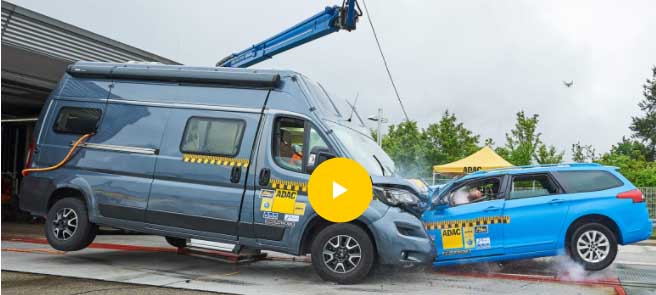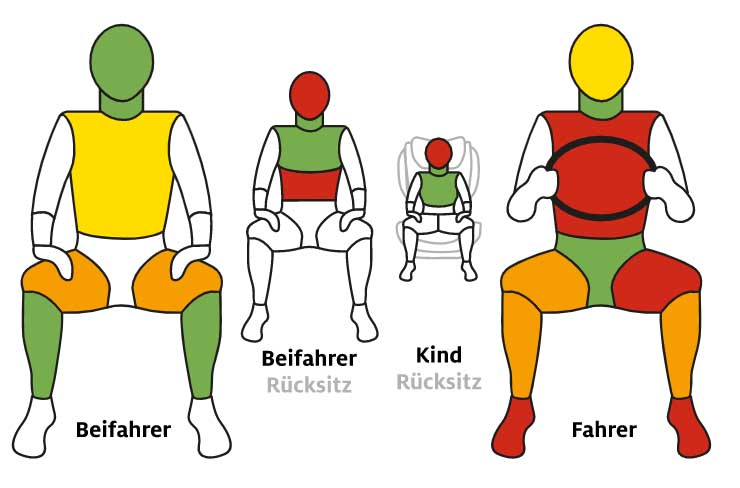Matches – Motorhome in a crash test.

How safe are popular vans converted into motorhomes in the event of an accident? The first crash test shows: There is a high risk of injury to the occupants in the event of a frontal collision. The number of motorhomes has been growing strongly for years. Passenger compartments do not withstand impact. Design flaws in the kitchen and rear seat.
The collision is violent: at speed 56 km / h with a fully loaded camper van and a station wagon collide head-on, slightly shifted relative to each other. 3,5 tons to 1700 kg. The motorhome rocks violently after a collision, moves forward, but it does not fall over. A test team from the ADAC Technical Center in Landsberg staged an accident, as could happen during a risky overtaking maneuver on a country road. The text: How safe is a van that has been converted into a passenger motorhome in the event of a head-on accident?
After the collision, the image of the damage emerges: the front of the estate car is severely deformed, and the passenger cell has exceeded its maximum carrying capacity. The driver's door is so jammed, that they can only be opened with heavy equipment – in an emergency, it would make the rescue operation much more difficult.
The situation in the motorhome is not better. The passenger compartment collapsed, the wheel broke through the floor, the floor pan is bulging, the driver's seat is tilted back. The driver's living space has shrunk significantly. When the bottom of the steering column is pushed into the footwell, the steering wheel moves forward and up.
As with a passenger car, also in the case of a motorhome, the emergency services would have a very difficult task. Again, the driver's door could only be opened with heavy equipment. The passenger door can be unlocked, but only with great effort. The rear sliding door does not open at all, only the rear door opens without problem.
If the delivery truck rolls over in such a collision, which almost happened in this accident, the situation is exacerbating. ADAC project manager Andreas Ratzek: “Then it would be even more problematic for rescuers, and passengers could be injured by flying objects.”

Even so, the risk of injury is already very high: The motorhome driver is at risk primarily in terms of the head, chest, legs and feet, just like the passengers of the car. Evaluation of the dummy data indicates serious injury. In the worst case, even life-threatening or irreversible injuries can occur. The risk to the passenger of the motorhome is much smaller. Especially, that the passenger cell on his side is hardly deformed.
The two rear passengers, on the other hand, face a high risk of injury. Because the back of the driver's seat tilts back in a very unusual way, and the rear seat console in turn bends very much forwards, passengers' heads approaching the front seat dangerously. There is a risk of serious head injuries here.
That's also why, that the wooden structure under the seat collapses, and the hard tubular frame of the backrest is exposed by the sliding cushion: On reflection, the head of an adult dummy hits it directly. In addition, because the seat belt hardly moves with the baby, severe internal injury and bleeding may occur.
In the case of a child, the protection provided by a well-secured seat prevents even worse consequences.
The camping has been booming for years, and the number of motorhomes in Germany has risen from 2011 a year by approx 77 percent. Vans suitable for everyday use are of particular interest: about six meters long, two meters wide, four seats and sleeping places, about 600 kilograms of load capacity, permissible gross weight 3,5 tony.
“These vehicles recently accounted for approx 41 percentage of new registrations”, says the ADAC. Martin Zöllner campsite. I: “They are especially popular with young families”.
In the past, other European institutions have carried out tests with semi-integrated camping vehicles, where only the sheet metal driver's cab has been taken from the base vehicle. Or with fully integrated ones – here only the chassis is from the base vehicle. The ADAC crash test with a disassembled delivery vehicle thus fills the gap.
ADAC testers chose a motorhome based on the Fiat Ducato for their test. With almost 50 percentage of shares and 60 percentage of new registrations, Fiat Chrysler (FCA) is an industry leader. For crash with Citroen C5, a car from the upper middle class, the motorhome is loaded in accordance with the regulations: The table in front of the double bench is removable and well stowed, just like gas cylinders, luggage, dishes, umbrella and camping chairs.
Of course, all passengers are strapped in: During the collision, these are four mannequins prepared using sensors – driver, front passenger and rear seat passengers, an adult and a child, which is optimally secured with the ISOFIX system and an additional Top Theter belt.
The kitchen turns out to be very unstable during a collision: the kitchen block breaks completely out of its anchoring, cabinets fly through the interior along with the contents. They were connected to each other with only a few screws, not with the car body. However, the rest of the motorhome survived the accident well: two double beds, bathroom, the cabinets in the rear and the mounting brackets in the trunk took the impact. The gas system protection is also working and the gas supply is interrupted. This minimizes the risk of fire.
One of the most important conclusions from the crash test: the crush zone of the base vehicle is too weak and completely overloaded. Whether, whether the motorhome is based on a passenger car, whether – as in the test – on a commercial vehicle: ADAC engineers are careful, that the front of the car should be designed like this, to dissipate the impact energy. In this way, the passenger cell would remain stable as an emergency survival space and protect passengers.
Testers recommend vans manufacturers, that they work on the stability of the internal components. “In the trunk, the cabinets are firmly attached to the vehicle frame, while at the front of the kitchen they are only screwed on, and the support posts are merely glued to the floor” – reports project manager Ratzek. “If the producers additionally secured the B-pillars, e.g.. tape, they could withstand a greater load”.
The testers would also like the much greater strength of the rear seat support structure, so that it does not collapse, as it happened during the collision. It would be possible, for example, to install a steel supporting structure instead of a cushioned wooden bench.
According to ADAC experts, The vehicle tested here is typical of vans converted into motorhomes. Nine out of ten motorhomes are similar in design, says Ratzek. To verify this assumption, ADAC will also check using the so-called. toboggan tests, how the rows of seats from other manufacturers behave under the exact conditions of a collision with a motorhome.
How to properly load a motorhome
Heavy things go to the bottom, light on top. If possible, only very light luggage should be stored in the overhead lockers, np. Clothes.
In the living area, hide as little as possible. Instead, use the rack to carry beverages and other heavy loads and secure them there with lashing straps on the lashing eyes.
It is best to use plastic dishes in the kitchen, not glasses or porcelain. Do not leave anything on the kitchen counter when traveling, but if possible, hide small items well.
When traveling, remove or fold down the dining table in front of the rear seat row or between the rear seat rows. Otherwise, the passengers may be seriously injured in an accident.
When purchasing a motorhome, make sure, that the car has assistance systems, such as Emergency Braking and Lane Departure Warning. Although they cannot prevent every accident, reduce the risk of an accident and can help to avoid serious injury.
See the video from the crash test of the Citroen C5 motorhome